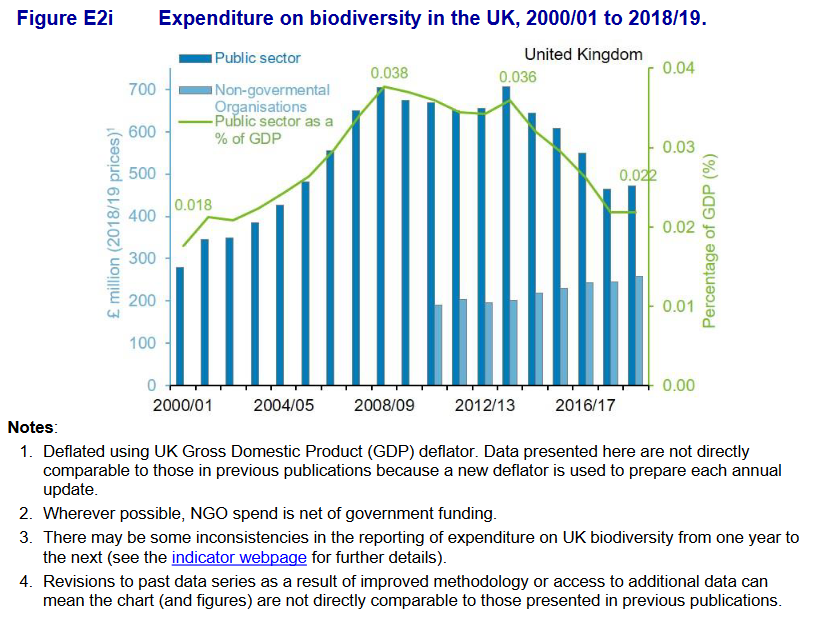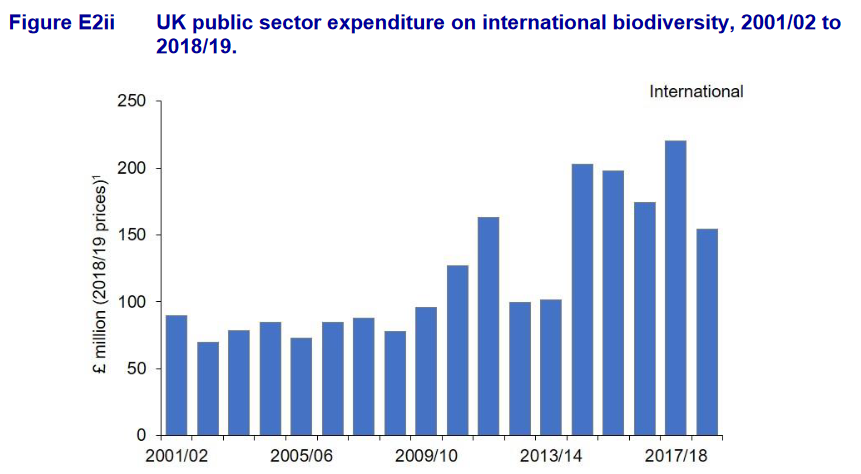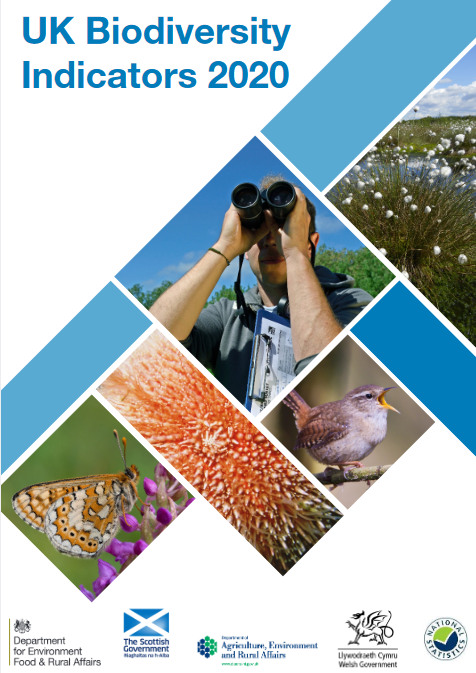Following three earlier blog posts today (here, here and here).
This is a quite spectacular graph showing the decline in public sector biodiversity spend in the UK over the last decade or so.

There has been a steady increase in expenditure by NGOs but not enough to fill the spending gap left by our taxes being spent elsewhere.
Funnily enough, having cracked how to save biodiversity at home (yes, that is sarcasm – see blogs 1 and 2 in this series today) we are now spending more money internationally.


It is interesting that the decline in public expenditure more or less coincides with Tory Governments taking over from the last of the Blair /Brown governments. However this is what one would expect as the Tories always view nature as basically getting in their way. Certainly my Tory MP has no real interest in helping nature. This I have gleaned from many communications with him over the years.
Again, the Government seems to more or less ignore the wealth of experience and data for helping farmland birds generated by the RSPBs Hope Farm in Cambridge. This is really showing how to conserve farmland birds while maintaining a profitable farm. Why oh why is not more attention paid to what they do on this Farm? They do brilliant work.
There is one welcome aspect however amid all this Governments gloom and doom and that is the increase in expenditure on wildlife abroad. That is desperately needed. About 90% of our threatened species occur in the UKs Overseas Territories.
Defra slipped this information out without fanfare in the hope that it would not be noticed and the response (or lack thereof) by the media and the opposition parties would suggest their hopes have paid off. It is up to all of us to make a fuss. Hopefully every MP will be receiving letters demanding an explanation for the continuing failure to reverse the decline in wildlife.
re status of priority species
“This selection is taxonomically
limited at present; it includes no vascular or non-vascular plants, fungi, amphibians, reptiles, or
fish. The only invertebrates included are butterflies and moths”.
I searched for the word fungi and this is what came up.
What happened to this lot
https://data.jncc.gov.uk/data/98fb6dab-13ae-470d-884b-7816afce42d4/UKBAP-priority-fungi.pdf
I believe that all they are saying is that the ‘priority species’ indicator includes only a restricted sample of all of the possible priority species. The report indicates that there are 2890 species identified as priority species but only 219 are included in the indicator because robust quantitative time series are not available for most of the rest.
“This selection is taxonomically limited”
A bit like the people presenting themselves for being voted into positions of power.
It would appear that the UK is not alone in poor funding and action when it comes to protecting our “protected” areas and biodiversity. The underlying problem appears to be the Common Agricultural Policy and it’s reward to intensive farming:
https://www.theguardian.com/environment/2020/oct/19/vast-majority-europe-key-habitats-poor-bad-condition-report
“The vast majority of protected landscapes across Europe are rated as in poor or bad condition and vital species and their habitats continue to decline despite targets aimed at protecting them, according to a report.
“Only a quarter of Europe’s species are rated as having a good conservation status, while 80% of key habitats are rated as being in poor or bad condition across the continent, in the State of Nature in the EU 2013-2018 assessment by the European Environment Agency.”
The trend we see in the UK appears to be repeated across Europe despite the politics of the party in power. Brexit provides an opportunity for the UK to reversere the declines but unfortunately that seems unlikely.
“The trend we see in the UK appears to be repeated across Europe despite the politics of the party in power. Brexit provides an opportunity for the UK to reversere the declines but unfortunately that seems unlikely.”
The map on page 45 of the publication Filbert links to below shows that the UK is about the worst country within the EU in terms of the conservation of its habitats. We can blame the EU and its CAP for the condition of much of our countryside but somehow other EU countries (generally less densely populated ones to be fair) have not seen as much damage.
As you say, Brexit perhaps provides an opportunity to do something different but the portents do not look good. There are honourable exceptions but most politicians do not seem to place the protection of wildlife very near the top of their priorities and certainly the present government does not strike me as placing very much value on a countryside filled with bird-song and the buzz of insects or splashed with the colours of wildflowers.
This is good/bad – depending
https://www.eea.europa.eu/publications/state-of-nature-in-the-eu-2020/at_download/file
“This is a quite spectacular graph showing the decline in public sector biodiversity spend in the UK over the last decade or so.”
It wasn’t unexpected. The trend has been repeatedly reported. Possibly here, and maybe elsewhere.
And so the response is to scrabble to find private sector funding. No! Whilst private funding is welcome, it must not be the scapegoat that lets government shirk its responsibility to all of us, to look after our natural environment. The eNGOs need to up their game to achieve proper funding for statutory nature conservation to fulfull our statutory conservation obligations and harness the benefits of nature based solutions for society